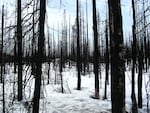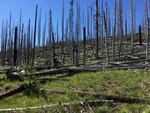
Researchers found that snow cover is a key driver of revegetation in heavily burned areas of the Cascades.
Kelly Gleason / Oregon State University
Blankets of white play a big part in restoring carpets of green after wildfire, according to a new study.
Researchers with Oregon State University and the University of Nevada, Reno found that snow cover is among the most critical elements to revegetating heavily burned areas of the Oregon and Washington Cascades.
“We’re in this period of climate change now where we know we have declining snowpacks, and that creates more moisture-stressed forests, and that leads to bigger fires, more severe fires,” said Anne Nolin, a snow hydrologist and professor at UNR who led the study. “And after fire, now we know that snow matters.”
Revegetation is important to post-fire recovery, as plants help stabilize soil, provide forage and habitat, sequester carbon, and improve water quality.
The researchers wanted to determine the key variables driving revegetation in severely burned zones across four distinct mountain regions: the Oregon and Washington Cascades, and the Northern Rockies of Montana and Idaho.
They used satellite data from NASA to read the “greenness” of summer vegetation in these areas, snow cover and precipitation. (Greenness, Nolin said, is a measure of plants’ photosynthetic activity, not how green it looks to the naked eye.) The study relied on data from two years leading up to a major wildfire and four years following.
The analysis found, to little surprise, that summer rainfall was the most critical factor in revegetation across each region. More surprising, Nolin said, was that snow cover proved particularly important to vegetation rebounds in the Cascades.

Vegetation regrowth in the B&B Complex burned area between Mount Jefferson and Mount Washington.
Courtesy of Anne Nolin / University of Nevada, Reno
Snowpack is like a frozen, above-ground reservoir. Drier parts of Oregon and Washington are heavily dependent on winter snowpack that melts slowly and evenly throughout the spring and summer.
Cascadian plants are, too.
“[The] growing season really apparently does depend very strongly on snow,” Nolin said, “and especially at those elevations where we used to have pretty regular snow cover, but now that snow cover has been declining because of warming winters.”
The study did not account for what type of vegetation grew back and only focused on severely burned areas.
But Nolin said the research underscores the importance of Cascade snowpack, which is increasingly threatened by climate change. The region has endured a steady decline in annual snowpack and could soon experience winters with little to no snow if humans are unable to curb greenhouse gas emissions from burning fossil fuels like coal and petroleum.
“In order to preserve those legacies of snow for future generations, we have to really act now,” said Nolin, also a longtime skier.
The study was published in the Journal of Geophysical Research: Biogeosciences.
